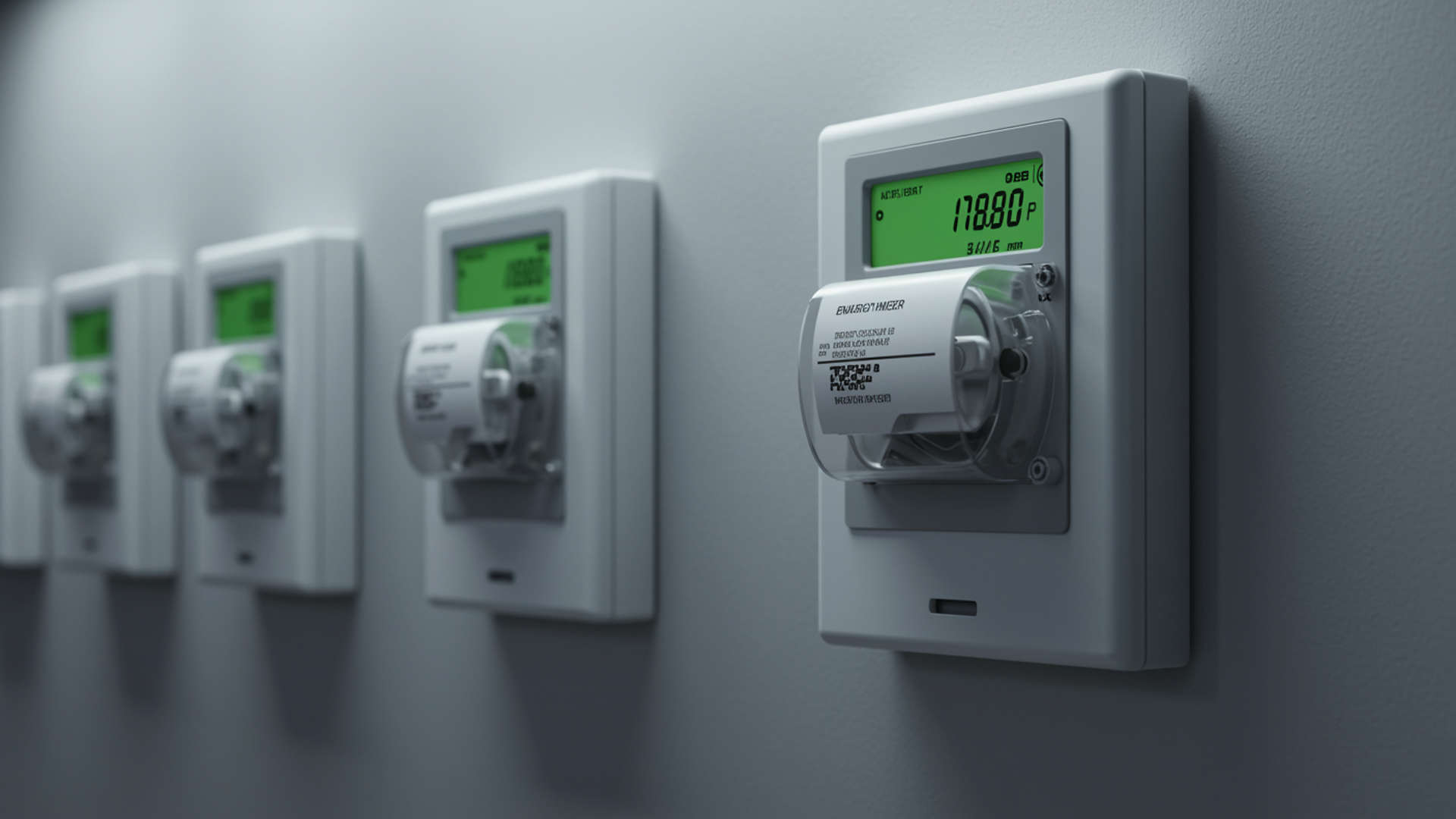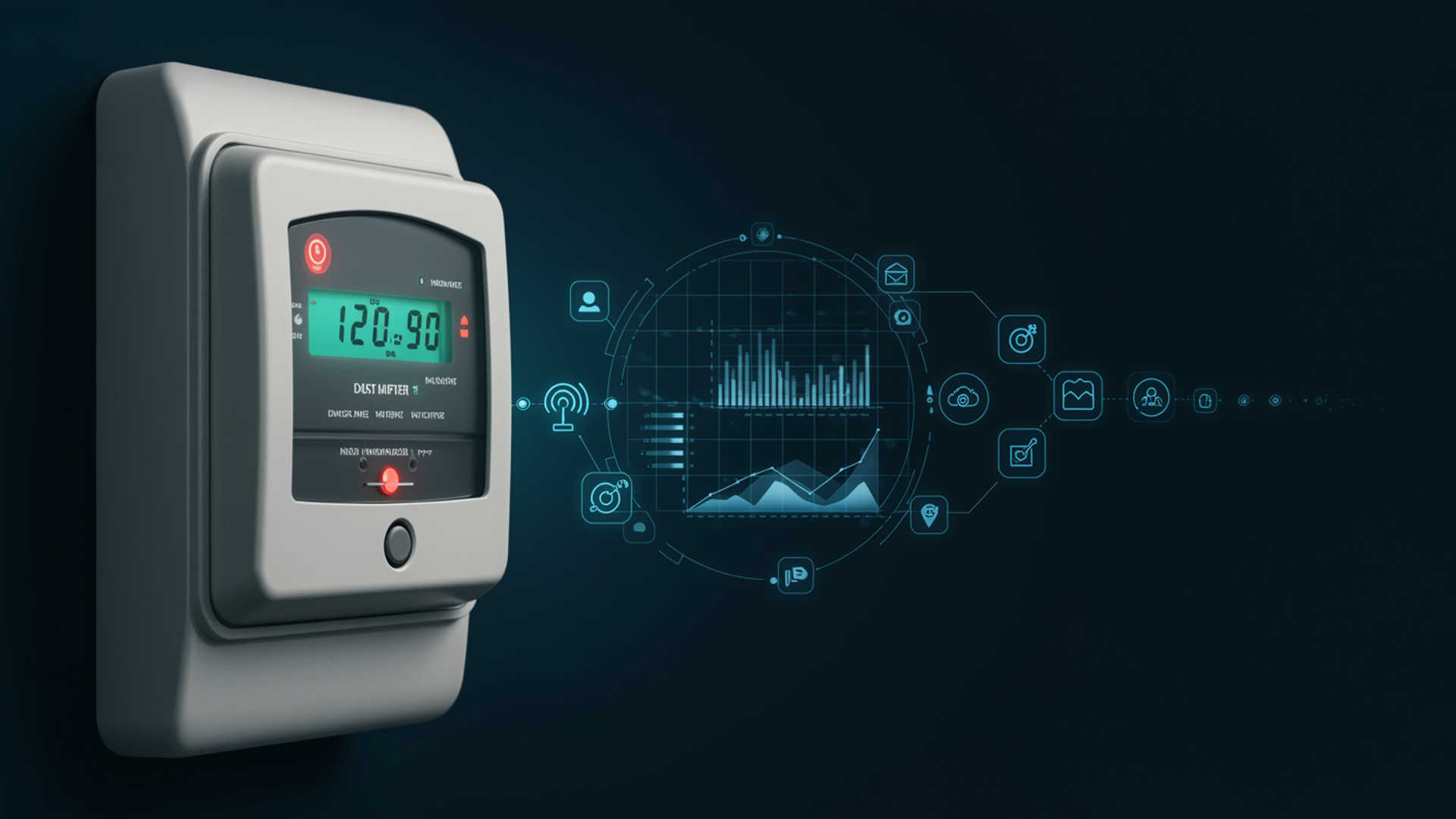Executive Summary
Smart metering water is becoming mission critical for utilities everywhere. Globally, the smart water metering market is estimated to reach USD 9.04 billion by 2030 (CAGR 11.9 %).
Meanwhile, studies by International Journal of Infrastructure Research and Management have shown that utilities globally lose roughly 35 % of treated water as non-revenue water (NRW), costing tens of billions annually. This guide explores how utility leaders can harness smart metering to convert losses into insights, mitigate risks, and drive measurable operational transformation.
What is Smart Water Metering?
Smart water metering, or water AMI metering is the end-to-end system that measures and records water consumption in near real-time. It connects state of the art flow-sensing meters to a communication network (secure, scalable) and a data management layer. Utilities gain near real-time visibility into water consumption, possible anomalies (leaks, backflow, tampering), and overall infrastructure health.
Beyond automated readings, smart meters in water utilities provide utilities with an operational foundation to improve billing accuracy, reduce NRW (Non-Revenue Water), enhance consumer transparency and ensure regulatory compliance.
- A study by Bluefield Research indicates that the global smart water meter market has already reached a value of $6.8 Billion.
- As per Berg Insight, there were about 42 million AMI endpoints for water meters by the end of 2024
- Polaris Research highlights the global market for AMI water meters is expected to grow at a CAGR of 11.85 from 2025-2034 with North America dominating the revenue share
How Smart Metering for Water Works: System and Architecture Overview
For water utilities, deploying smart meters requires a well-structured architecture that connects device-level telemetry data to enterprise-wide decision-making. Let’s explore the architecture of a modern smart metering network, and how each component supports system performance, data integrity and cross-functional transparency.
Data flow: From meter’s edge to utility action
Smart meters
These digital devices are embedded with IoT sensors that measure water flow at different intervals throughout the 24-hour window. Smart water meters can also detect events like continuous flow (which might indicate leakage), reverse flow (backflow), pressure anomalies, or device tampering.
Head-End System (HES)
HES collects data from multiple meters, schedules reads, manages retries, processes firmware updates, and acts as the communication termination point.
MDMS (Meter Data Management System)
They conduct VEE (Validation–Estimation–Editing) analysis once the meter is transmitted from HES. MDMS is critical to ensure data integrity, track cadence compliance (e.g., hourly reads vs bursty uploads), handling gap-filling logic, and maintaining auditable records.
Billing/Analytics
Validated data flows into utility systems for billing and reporting, with analytics dashboards providing insights into loss patterns, regional demand trends, and asset performance.
Operations (OMS/WFM)
Smart metering solutions enable auto-detection of potential anomalies and triggering workflows that are routed to field teams. AMI platforms also come with SLA tracking capabilities that ensure timely resolution and verification of meter/site health.
Customer portals
Utility metering platforms also provide self-service dashboards that surface real-time usage, high-flow alerts, and seasonal patterns. This level of insights helps reduce the influx of support calls and improve the overall customer experience.
Meter → HES → MDMS (VEE) → Billing & Analytics → OMS/WFM → Customer Portal
Communication network: RF, cellular, PLC
The mode of network in which a smart meter shares data back to the utility’s central server is critical. The mode of communication chosen by any utility will depend on factors like cost, location, regulatory laws, coverage and reliability.
Leading utilities in the U.S. are now deploying hybrid architectures—RF mesh for city cores, and NB-IoT/cellular for rural or hard-to-reach endpoints. Before the roll-out phase, the utility must evaluate their choices based on terrain, maintenance costs, deployment timeline, and firmware update capability.
Telemetry & Event Intelligence
Smart meters in water utilities generate more than just consumer usage. AMI solutions also provide insights into event and anomaly trends, enabling utilities to identify issues that may escalate in the future and prevent costly maintenance programs.
- Interval-based readings: Hourly or configurable windows for tracking consumer usage and demand patterns.
- Continuous flow: Non-stop flow of water, indicating early signal for leakage or faucet issues.
- Backflow events: Reverse flow of water back to the utility, raising water health and regulatory concerns. Smart meters can be configured to trigger automatic work orders.
- Pressure anomalies & tamper alerts: Near-real time tracking of water pressure and instances of tampering, supporting proactive asset management.
- Firmware version & battery status: Comprehensive device lifecycle management, ensuring transparency into asset health and proactive maintenance approach
Smart Water Meters vs Traditional Metering Systems
For water utilities that are looking to adopt smart meters, they must understand the value of AMI against regular meters. It is critical to have an understanding of how they compare against legacy systems in terms of functionality, operational value, data management, consumer engagement, etc.
The evolution of water utility metering typically follows three key stages:
Analog → AMR (Automated Meter Reading) → AMI (Advanced Metering Infrastructure).
Benefits and Outcomes of Smart Water Metering
AMI water metering provides utilities with organizational-wide visibility, cost efficiency, and measurable outcomes. Listed below are some of the core advantages of smart metering in water utilities.
NRW Reduction & Leak Detection
Research indicates that NRW (non-revenue water) constitutes 30% of global water system input volume, amounting up to $39 billion in costs.
Smart meters provide fine-grained consumption and pressure data, which allow utilities to detect hidden leaks before they escalate. Utilities can set night-flow monitoring, water pressure baselines, and automated alerts for threshold-crossing to flag anomalies early.
Result: Reduction of non-revenue water and waste, and cost savings in water production and treatment.
Backflow & Safety Monitoring
AMI systems can detect reverse flow events (backflow) and auto-trigger alerts to prevent contamination risks. With this capability, utilities are better positioned to meet public health standards and mitigate exposed risk in distribution networks.
Result: Enhanced operational safety and timely interventions, reducing water quality incidents.
Revenue Protection & Meter Integrity
Smart metering systems can identify meters that are active but unregistered or mismapped, which sometimes happen in legacy systems. Utilities can triage these anomalies and enforce frameworks to ensure data integrity.
Result: Better billing accuracy, reduced losses due to unbilled consumption, and cleaner customer datasets.
Operational Efficiency & Crew Productivity
By converting flagged events into digital tickets and field workflows, smart meters reduce reliance on routine manual inspections. Field crews are now dispatched specifically for high-priority issues, avoiding wasteful dispatches.
Result: Lower operational expenditures (OPEX), fewer truck rolls, and improved crew utilization.
Enhanced Customer Engagement & Conservation
Modern smart metering solutions often include customer-facing portals and alerts, providing visibility into their usage patterns, leak alerts, and historical comparisons.
Result: Improved customer satisfaction, reduced complaints, and more proactive water conservation behavior.
Governance, Auditability & Compliance
Utilities can now maintain auditable data in their database. Be it real-time usage data, billing, or operational logs, every data point is updated with detailed metadata, lineage, and role-based access controls.
Result: Easier regulatory compliance, streamlined audits, and defensible processes in billing disputes.
Potential Risks of Smart Water Metering
Smart meters provide water utilities with a host of operational, and financial benefits. That being said, utility leaders must keep note of valid concerns often tied to health, privacy, cybersecurity, and change management.
In this section, we break down each challenge transparently, along with most suitable risk mitigation frameworks.
Data Privacy and Granular Usage Patterns
Smart water meters collect interval consumption data, it can be hourly or even once a day. If such high-volume data is mishandled, it can reveal behavioral patterns such as occupancy, irrigation timing, or anomalies in household routines.
To address this, utilities must deploy:
- Data minimization strategies ensure only essential data is retained
- Customer-facing portals that use aggregated data, not raw intervals
- Role-based access control (RBAC) for internal teams to govern who can access detailed datasets
- Retention policies that automatically anonymize identifiable data after a specific period
In accordance with RCW 19.29A.100 requirements, US utilities are forbidden from selling private consumer information. The law also prohibits the use of any proprietary data for third-party needs or marketing without prior customer approval.
Cybersecurity Vulnerabilities
AMI networks, be it water or electric utilities, consist of thousands of edge devices, head-end systems, data concentrators, and cloud or on-prem analytics layers. And each of these layers presents an opportunity for cybersecurity attacks.
To counter these risks, utilities must align their cybersecurity programs with NISTIR 7628, the foundational guideline for secure smart grid operations. Key practices include:
- Network zoning and conduit segregation to isolate critical operations
- Certificate-based authentication and firmware lifecycle management
- Least privilege access for operational staff
- Real-time logging and monitoring with incident response protocols
No utility system is ever truly free from cybersecurity attacks, but aligning with NISTIR 7628 and utility-specific benchmarks reduces the level of threat exposure. Today, a proactive cybersecurity design is becoming more critical than ever before, as water infrastructure becomes more digitized.
Grid in Action: Smart Water Metering Use Cases with Measurable Outcomes
Your smart water meter investment alone will not deliver outcomes. For any utility, the true value is realized when water meter data drives action, and enhances operational decision-making. In this section, we will look at two real-world use cases where Grid, our utility data management solution, streamlined data management, reduced losses and improved ROI for leading water utilities.
Use Case 1: Ensuring Revenue Protection by Detecting Leakage and Anomalies (480,000+ smart meters)
The Challenge
A large metropolitan water utility had rolled out over 480,000+ smart water meters, but faced major challenges in operationalizing the data. There was no set cadence (how often the data would arrive for each meter), often resulting in:
- Leak events and backflow incidents were not discovered in early stages, impacting billing cycles and leading to consumer complaints.
- Field teams lacked a consolidated view of utility data, which made proactive interventions nearly impossible.
- No centralized platform to manage or track issues, from identification, ticket to closure
How Grid Helps
The utility implemented Grid’s SMOC or an intelligence-driven Smart Meter Operations Center (SMOC), and the following capabilities were deployed:
- Cadence-aware completeness monitoring: Grid auto-identified silent, or inconsistent meters by comparing real-time arrival rates against expected schedules (hourly, 15-min, or 48-per-day patterns). This ensured billing readiness and eliminated data blind spots before invoices were generated.
- Segment-aware leak detection: Night-flow rules were configured based on customer categories (e.g., residential vs. industrial). This feature helped reduce false positives and field teams can now prioritize real leaks over noisy alerts.
- Backflow monitoring with safety checklists: Reverse flow events were captured via telemetry and any sustained event is logged as high-priority. Grid auto-triggers checklists, ensuring each incident is triaged, verified, and resolved systematically.
- Revenue protection via unmapped meter detection: if any meter is showing consumption, but not mapped to any consumer, then it is automatically flagged. A ticket is created for field teams with evidence (location, last reads, mini chart).
Measured Impact
- 95,000 potential leak events were flagged within a 72-hour window
- 1,159 backflow events were detected across both residential and industrial zones
- 309 unmapped devices were identified, some consuming over 86 m³ within 72 hours,
- Operational managers could now view real-time dashboards of meter data arrival by geography, cadence, and vendor type
Use Case 2: Streamlining project management for a multi-district water utility program
The Challenge
A utility overseeing a nationwide reservoir and pipeline upgrade program, faced execution delays due to:
- Fragmented reporting from multiple contractors and engineering teams
- Inconsistent milestone tracking in projects across regions
- Spreadsheet-based material tracking that caused procurement lags and rework
- Lack of transparency into bottlenecks (ROW issues, permits, dependency delays)
The Grid Solution
The utility deployed Grid’s no-code solution that combined GIS-first governance, mobile reporting, and low-code workflows. Key features include:
- Milestone-level map views: Each reservoir, trunk line, and distribution pipeline segment is now color-coded based on start, progress, or completion status. Stakeholders just need to click into each node, and get details into pending/completed tasks.
- Mobile-first progress reporting: Users built custom forms on Grid’s Frontline App forms to capture site updates with timestamp and geo-tags for field teams. removing manual errors and backlogs.
- Inventory-aging dashboards: Material availability and consumption is now traced end-to-end; streamlining procurement and minimizing shortages.
- Hindrance tracking: Bottlenecks like permit delays, and inter-team dependencies are tracked with closure timelines, with dashboards highlighting priority hindrances.
Measured Impact
- Real-time leadership view of what’s behind, what’s at risk, and where effort must be focused
- Reducing uncertainty in contractor billing and approvals with real-time tracking
- Inventory Optimization as material flow aligned with work plans and rework is minimized
FAQs (Frequently Asked Questions)
What is smart water metering?
Smart water metering is the use of connected digital meters to measure consumption at set intervals, and auto-transmitting that data back to the utility. As per US EPA (Environmental Protection Agency), smart meters enable faster detection of leaks, anomalies, improves data reliability and enhances billing.
How does smart metering work for water utilities?
Smart meters collect usage data and share it to the HES (head-end-systems). After that, it is sent to MDMS before feeding the data for operations and billing. This AMI framework allows real-time monitoring, alerts and reporting across teams.
What are the disadvantages or risks of smart water meters?
There are some concerns regarding cybersecurity, privacy and RF exposure. However, the health impact of smart meters is minimal. Utilities can also mitigate cybersecurity and privacy risks via encryption methods, role-based access controls and following NIST frameworks.
Is there any difference between regular meters and smart meters in water utilities?
Legacy meters often require field personnel to visit locations and perform manual readings, with no view into real-time data. Smart meters on the other hand, provide automated two-way readings, leak detection features and portals for consumer support. They can also integrate seamlessly with existing utility systems, improve billing accuracy and improve NRW.
Which KPIs should water utilities track after deploying smart meters?
Key KPIs include percentage of validated reads, leak detection resolution time, improvement (if any) in backflow detection & resolution, revenue recovered from unmapped meters, etc.
Conclusion: Turn Your Smart Water Metering Data into an Operational Advantage
Utilities today cannot afford blind spots in their distribution networks. Smart water metering offers several advantages, from real-time visibility, anomaly detection, service reliability, enhanced network performance and more. That being said, building a future-ready AMI network needs to go beyond hardware investments. It must be paired with robust analytics, reporting, data governance and field responsiveness.
This is where solutions like Grid come into play, connecting meter data to operational KPIs, aligning stakeholders, and enhancing consumer trust. Utilities are able to form ‘knowing’ to ‘doing’ with ease and purpose, delivering greater efficiency and accountability, at scale.
Learn how Grid helps water utilities drive ROI post-smart meter deployment. Connect with our team today.



.jpg)








